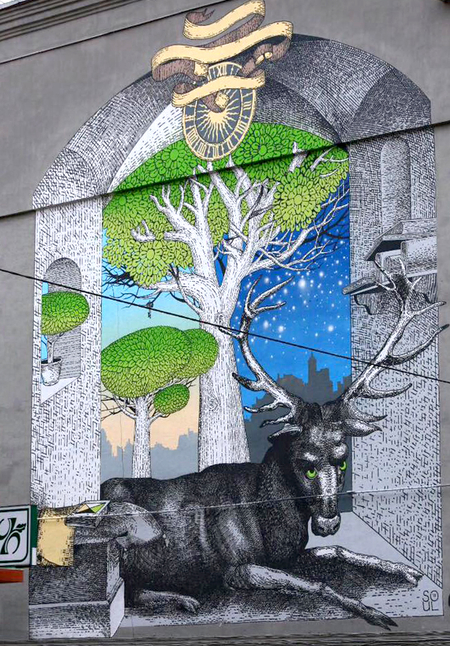Mural as a symbol of German-Ukrainian relations
Hope, depth, and ardor were “encrypted” in Kharkiv on the wall of a building next to which there was a Lutheran church
An impressive and highly symbolic mural has appeared on a wall of the building on 28, Pushkinska Street, in Kharkiv. It is opposite this building that a German Evangelical-Lutheran church, known in the city as “Kirche,” was opened and blessed in 1913. The church was torn down in 1958, but it seems to have left its shadow on this building “as a keepsake.” In the opinion of Tetiana Havrysh, the Honorary Consul of Germany in Kharkiv, and Wolfgang Moessinger, Consul General of Germany in Donetsk, this wall has become a symbol of Ukrainian-German relations.
“There is no better way to keep the memory of the people who used to live, work, and pray here. For the Kharkivites, who will be passing by the mural, this will be a brilliant reminder of the rich history of Ukrainian-German relations,” Mr. Moessinger pointed out.
Indeed, although the mural’s unveiling was timed to the 25th anniversary of Ukrainian-German diplomatic relations, cooperation between the two countries has far deeper roots. For example, the Ukrainian Kharkiv and the German Nuremberg have been twinned for 27 years now.
Esthetically, the mural bears the signs of symbolism. It has “encrypted” the symbols that far from all can decipher. This mural combines both Ukrainian and German features which have long intertwined and become part of a common history.
“You can notice here the esthetics and the themes of Albrecht Duerer’s works. It is important both to Kharkiv because his graphic pictures are kept here and to the artist’s native Nuremberg which is, incidentally, our twin city,” project curator Daria Khrysanfova says. A special student contest was held to select a mural sketch. Oleksii Postulha, Denys Stadnyk, and Oleksii Filipov won the competition. The Consulate General of Germany and Karkiv’s Kyivskyi District Administration helped them implement their idea. Even some private entities joined in – a cafe supplied the artists with hot beverages because they not always worked in good weather, and a German company made available bright and high-quality paints.
“Murals are now a trend of world megalopolises. And we will be glad to help enliven the urban space with bright landscapes and thus boost the mood of Kharkivites,” Oleh Sierov, a representative of the sponsor company, said.
To create the mural, the artists chose the green and blue colors – the symbols of hope and depth. Some may be surprised with a colorful deer in the picture. But the artists argue that it is in this case a symbol of ardor, of the ideas of creating something in common, of friendship between Kharkiv and Nuremberg. The tree of knowledge, also present in the mural’s composition, conveys an encoded philosophical message too – the two cities are very different, but the tree of life and knowledge can unite them.
The unveiling of the mural marked the beginning of the now traditional Weeks of Germany in Kharkiv, which annually present a lot of interesting educational and artistic events to city residents.
Newspaper output №:
№71, (2017)Section
Time Out





